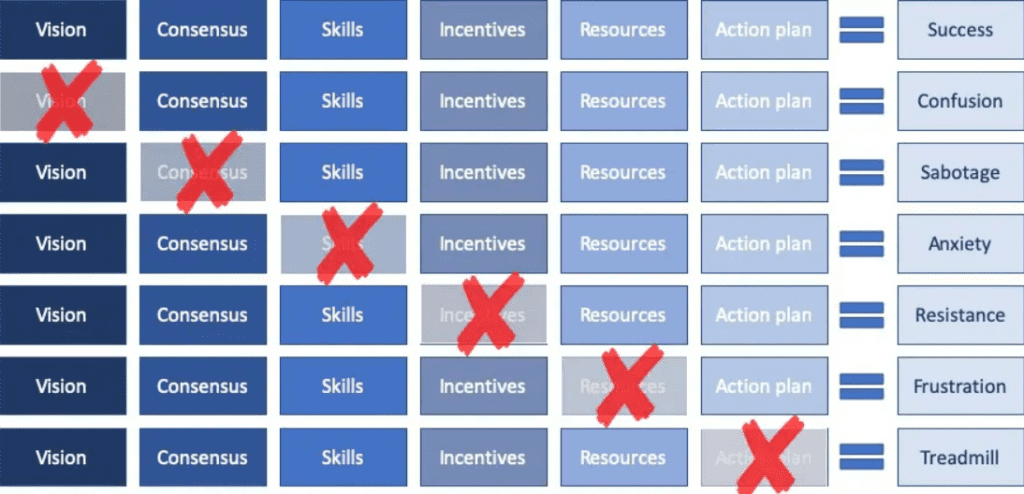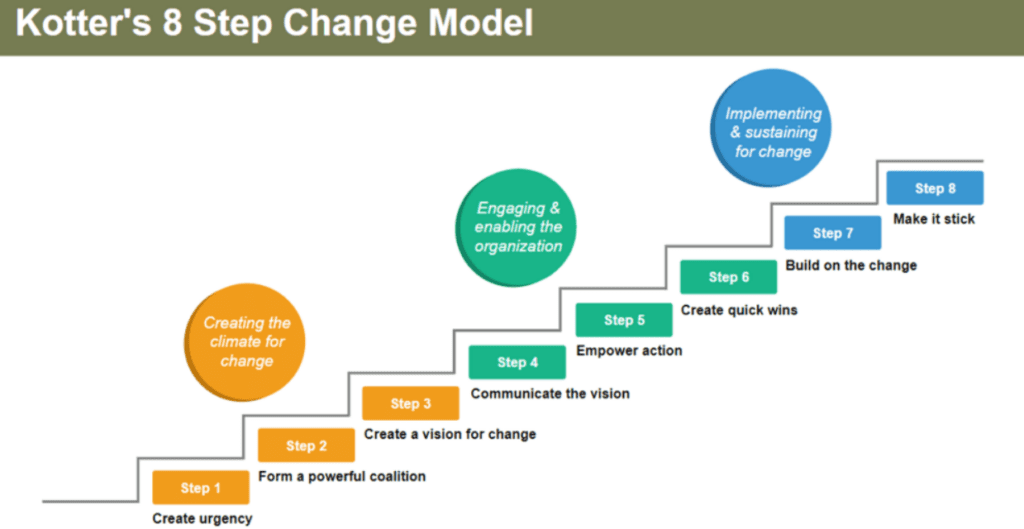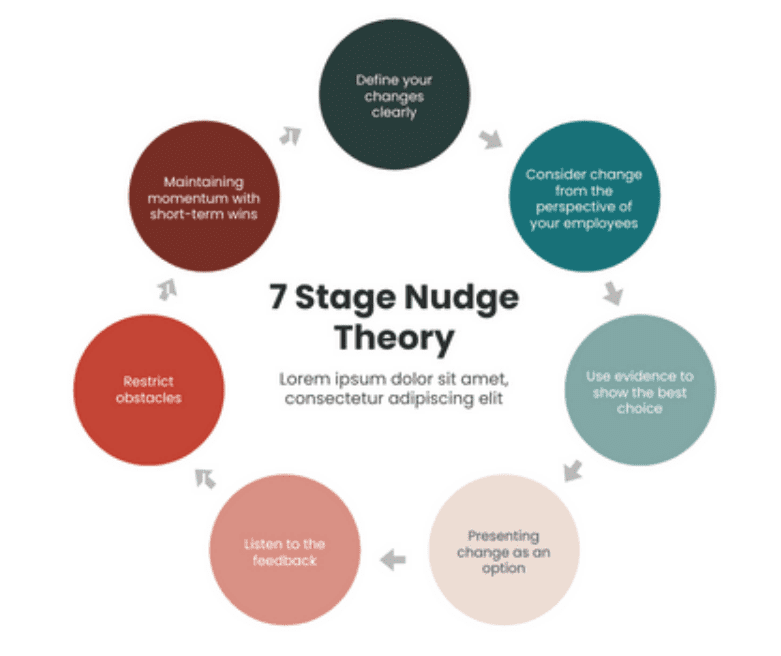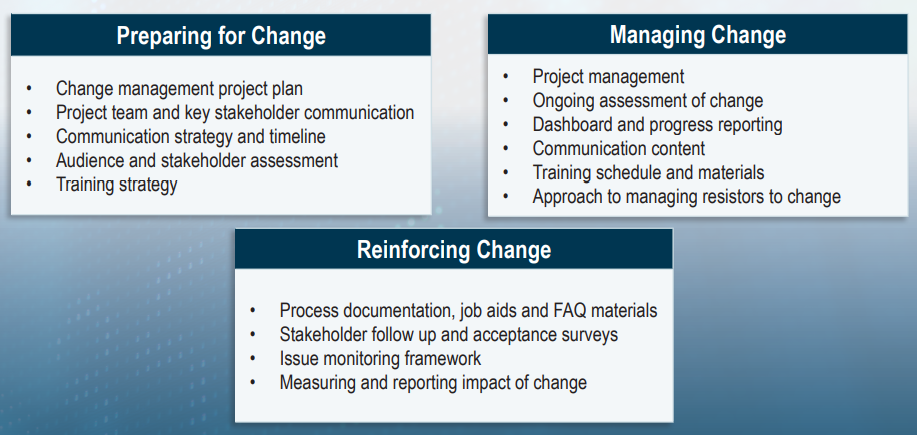Change is inevitable, but successfully managing it isn’t. During times of organizational transitions, a holistic effort that begins with preparation, moves into execution, and continues with ongoing reinforcement is essential.
What’s So Complicated About Change Today?
Think of the highly varied work that goes into managing complex change, such as transitioning data from an on-premises environment to the cloud, integrating the production systems of a recently acquired business, or rolling out a fleet of 5G-capable devices at a hospital.
Beyond marshaling the raw technical expertise necessary for determining what’s practical and on what timeline in scenarios like these, senior leaders and managers must also:
- Review potentially applicable rules, regulations, and legal precedents, such as data privacy implications and employment practices laws.
- Analyze the impact on company culture, including possible reorganization of teams and where they may work in the future, whether in-office, remote, or a combination of the two (i.e., hybrid work).
- Consider how employees, customers, the public, competitors, and regulators may respond to any prominent action.
- Plan and execute a communications strategy accounting for all of the considerations above.
Overall, managing complex change means steering projects that often have technological, cultural, and organizational dimensions, on top of all of their usual implications for the company bottom line. Such issues naturally test an organization’s change management strategy, creating challenges on top of the fundamental uncertainty and resistance that any type of organizational change may inspire.
Change Management Model Examples
Complex change warrants considerable detail and emphasis on a change management model that provides the guardrails, definitions, stakeholders, and processes for seeing a clear path forward despite expected obstacles. Ultimately, the model of choice can be configured to meet the needs of any organization or crafted entirely from scratch.
One common framework, for instance, is the Lippitt-Knoster model, popularized in academic circles in the 1980s with roots dating back to research in the 1950s. This model, which has been iterated upon for decades, is effectively a matrix for managing change based on six pillars and their relationship to one another. If certain elements are missing in the change process, the effort will result in varying kinds of failure, as seen below:

(Source)
Another example is the Kotter model, developed by Dr. John Kotter of Harvard Business School in the 1990s. This approach rests on eight linear steps that focus on the business impetus and cultural context in which change is ultimately necessary, seeing the process through from start to finish.

There are dozens more theories and methodologies for executing a change strategy. Often, however, they have an end point, when in reality, there isn’t a hard stop to executing change given the pace of modern business and other influences on the resilience or “stickiness” of change, such as employee turnover (loss of tribal knowledge and change agents), technological innovation (like ChatGPT), and corporate reorganizations that undermine the original thrust and momentum of change.
Given the bevy of threats to adopting and maintaining change, it’s imperative that companies leverage a change management model that heavily emphasizes continuous reinforcement. In this way, change management is circular, not linear. That’s one key advantage to the “nudge theory” of change management, an amorphous yet continuous methodology for prompting grassroots change intuitively throughout every layer of the organization.
Nudge theory made its way into the change management lexicon in 2008 thanks to behavioral economists Richard Thaler and Cass Sunstein. This model posits that with the right incentives and pathways, employees can identify and conduct change efforts more rapidly and effectively than a traditional top-down enforcement approach. Employees simply need nudges to take action, and they should be empowered to choose to act versus being forced to. This subtle shift in mindset — willful enthusiasm for change — stands in contrast to conventional change management efforts that commonly feel arduous, unclear, and unmotivated.

(Source)
The important thing to note regardless of the model chosen is that all forms of change must be managed holistically, not in cookie-cutter steps with obvious beginnings and ends.
Holistically Managing Complex Change
Continuous and holistic change processes enable organizations managing change to mitigate risk and emerge on the other side with less of the pain and disruption so often associated with big change.
An effective change management model won’t shy away from the complexity involved. Instead, it’ll address this complexity directly through the expertise and experience of its practitioners, as characterized by three key competencies:
1. Planning for Complex Change
Before managing complex change, an organization needs to know the sources of that change — e.g., technological advancements, new competitors, evolving regulations, and corporate transactions — along with both the current and intended future states of operations. It must also understand who will be impacted by the change and how they will be affected.
Planning provides an opportunity to assess audience and stakeholders and to make sure that teams aren’t left managing complex change on an ad hoc, reactive basis with insufficient staff and a disorganized strategy.
2. Managing Complex Change
Project management, supported by ongoing assessment of progress (e.g., through dashboards and surveys), is integral to this aspect of managing complex change, as is the handling of any likely resistors to change. This is an opportunity to leverage trusted project management principles like agile to your benefit.
Timely communication via appropriate channels and content help alleviate the anxiety that employees may feel about an impending complex change. For example, a transparent, realistic description of what the change entails and why it’s happening may gain more employee buy-in than trying to oversell how great and painless the change will be in theory.
3. Reinforcing Complex Change
As referenced before, this step is the one that often gets forgotten.
Just because a company has finished preparing for and then managing complex change doesn’t mean that that change will endure. It needs reinforcement as part of a continuous action plan.

Creating process documentation that encapsulates the change management process, writing accessible FAQ materials and help center articles, and following up with stakeholders until attaining a statistically valid response rate for acceptance surveys all help in this regard.
Executed well, these three competencies improve adoption, increase effectiveness, and foster trust across the lifecycle of a change management project.
Four Key Tasks for Complex Change Management
Irrespective of the model an organization opts to follow, it must formulate policies with well-defined employee expectations and rules. People are the primary drivers of success or failure.
Leadership must be prepared to manage people and processes across multiple fronts through:
1. Impact Planning
What’s the impact on employee morale and workplace culture? Who is most impacted by this shift in business practices? What do those impacted need to be successful once the change is made? Will the customer experience be impacted, and if so, do employees have the necessary skills to accommodate on day one?
2. Communication
Is the company working toward clear, achievable goals for its teams? Are there useful feedback loops, tapping into multiple channels such as email and online meetings, in place to gather feedback and ideas from stakeholders along the way? And can that feedback be translated into corrective actions as needed to avoid undue frustration?
3. Training
How does the company plan to transfer knowledge between leaders and teams? Is an online information hub available? What training schedules and materials are feasible based on the geographic distribution of employees?
4. Management
Does this overarching initiative for managing complex change account for all of the definitely and potentially affected people, processes, and technologies? If it succeeds, will it reliably improve retention, lower costs, and deliver other sought-after benefits and savings? Have any dashboards been configured, or surveys drawn up, to track the progress of these granular goals against the overarching change management plan?
Ultimately, every project is a change management project, because change is constant and ubiquitous. However, despite being the mainspring of business transformation, change management programs often lack the resources required for their success. Famously, 7 in 10 change initiatives fail, and the causes of failure range from inadequate employee buy-in to management-side anxieties about the cost of change.
Resulting actions, such as cutting the change management budget, only diminish the prospects of succeeding at executing complex change. But change management is an investment that can’t be sold short. Naturally, managing complex change is never simple — but having access to the right expertise and experience makes it more straightforward than going it alone.
For expert support in your next change initiative, contact CrossCountry Consulting.